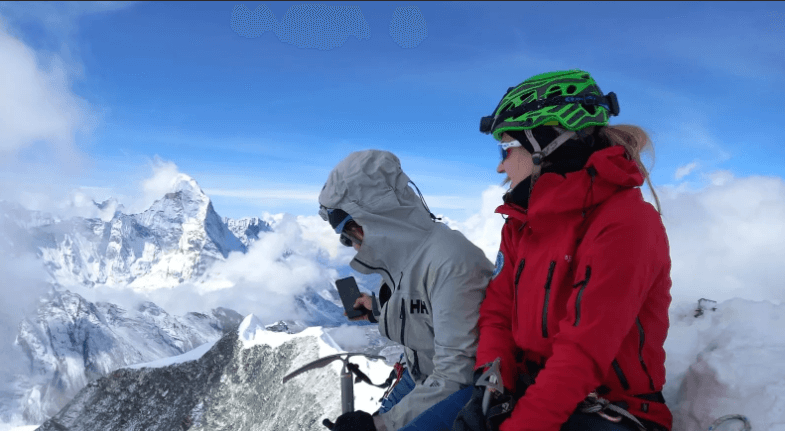17th June, 2025

Jun 03, 2024
Island Peak Climbing In August
- Why Island Peak in August
- I Never Climbed a Mountain, Can I Climb Island Peak?
- Packing Lists for Island Peak Climbing for August
- Training for Island Peak in August
- Weather, Climate, and Temperature in Island Peak in August
- Solo Climbing to Island Peak
- Is Island Peak Dangerous in August?
- I am a Beginner Climber, Can I Do This Climb?
- How Hard is the Climb of Island Peak?
- Distance of Island Peak
- Final Say
- Island Peak Climbing Packages
In August, Island Peak presents an enticing challenge amidst Nepal's monsoon season, offering adventurers a unique perspective on high-altitude mountaineering. Rising to 6,189 meters (20,305 feet) in the Everest region, Island Peak, or Imja Tse, stands as a formidable peak that combines technical climbing with breathtaking Himalayan vistas.
The journey to Island Peak typically begins with a scenic flight from Kathmandu to Lukla, followed by a trek through lush green landscapes adorned with blooming rhododendrons and cascading waterfalls. August brings the monsoon rains, transforming the region into a verdant paradise filled with fresh mountain air and vibrant flora.

ISLAND PEAK CLIMBING
This is a fantastic climbing expedition that takes you to the summit of "Island Peak (6,189m) situated between Amadablam and Lhotse mountains. This exciting adventure is jam-packed full of features an...
Despite the unpredictable weather, which includes frequent rain showers and cloudy skies, climbers experience the raw beauty of Nepal's landscape rejuvenated by the monsoon. Clear weather windows between rain showers offer glimpses of towering peaks like Everest, Lhotse, and Makalu, adding to the allure of the climb.
Ascending Island Peak demands physical endurance and technical skill, navigating steep snow and ice slopes using crampons, ropes, and ice axes. The summit day is a test of determination amidst swirling clouds, culminating in panoramic views from the summit, rewarding climbers with a sense of achievement and awe.
Descending through the Khumbu Valley, climbers reflect on their journey, enriched by the camaraderie forged on the trail and the serene majesty of Nepal's monsoon landscape. Island Peak in August is not just a climb; it's an immersive adventure that blends physical challenge with the captivating beauty of the Himalayas during a lesser-explored season.
Why Island Peak in August
Choosing to climb Island Peak in August offers a distinctive adventure amidst Nepal's monsoon season. While this time of year brings unpredictable weather with frequent rain showers and cloudy skies, it also transforms the landscape into a lush green paradise. The trails are less crowded, providing a quieter trekking experience through verdant valleys adorned with blooming rhododendrons and cascading waterfalls.
For those seeking a unique challenge, August allows climbers to test their skills in navigating wet and slippery terrain, enhancing the technical aspects of the climb. Despite the weather challenges, clear weather windows between rain showers can offer stunning views of the surrounding Himalayan peaks, including Everest, Lhotse, and Makalu.

EBC TREK WITH ISLAND PEAK CLIMBING
This exhilarating and unforgettable trek for adventure seekers takes you to the summit of "Island Peak (6,189m) situated between Amadablam and Lhotse mountains. This amazing adventure is packed full o...
Climbing Island Peak in August requires careful planning and flexibility to adapt to changing weather conditions. It's an opportunity to experience Nepal's natural beauty in a different light, with vibrant landscapes and serene mountain vistas that contrast with the bustling seasons.
I Never Climbed a Mountain, Can I Climb Island Peak?
Climbing Island Peak is feasible for individuals with no prior mountaineering experience, provided they have good physical fitness, mental determination, and are willing to undergo thorough training and preparation. Island Peak, standing at 6,189 meters (20,305 feet), is considered one of the more accessible 6,000-meter peaks in the Everest region, making it suitable for beginners under the guidance of experienced guides.
Before attempting Island Peak, beginners should engage in a structured training program that includes cardiovascular exercises like hiking and running to build endurance. Strength training focusing on lower body muscles and core stability is essential for carrying gear and maintaining balance on steep slopes.
Training should also include practicing basic mountaineering skills such as using crampons, ice axes, and ropes. Acclimatization is crucial to prevent altitude sickness, so climbers should plan for gradual ascent and rest days along the trekking route.
Hiring a reputable trekking agency that provides experienced guides and support staff can enhance safety and the overall climbing experience. With proper preparation, guidance, and determination, beginners can embark on a rewarding journey to conquer Island Peak and enjoy the breathtaking beauty of the Himalayas.
Packing Lists for Island Peak Climbing for August
Packing for an Island Peak expedition in August requires careful consideration of gear suitable for monsoon conditions and high-altitude trekking. Here’s a comprehensive packing list:

19 Days Everest Base Camp with Island Peak Climbing
This is a must for those adventurers–seekers who are physically fit or have previous climbing experience. This is one adventure that will make your toes curl and give you an adrenalin rush as you clim...
Clothing:
- Base layers: Moisture-wicking tops and bottoms.
- Insulating layers: Fleece jackets or down jackets.
- Outer shell: Waterproof and windproof jacket and pants.
- Headwear: Warm hat, sun hat, and buffs or neck gaiters.
- Gloves: Insulated gloves and liner gloves.
- Footwear: Sturdy trekking boots with good grip, gaiters, and trekking socks.
- Trekking attire: Comfortable trekking pants and shirts.
- Undergarments: Moisture-wicking and comfortable.
Climbing Gear:
- Climbing helmet
- Climbing harness
- Crampons suitable for wet conditions
- Ice axe
- Trekking poles
- Locking carabiners and quickdraws
- Prusik loops and cord
Accessories:
- Sunglasses with UV protection
- Headlamp with extra batteries
- Sleeping bag suitable for cold temperatures
- Duffel bags or backpacks
- Waterproof stuff sacks or dry bags
Personal Items:
- Sunscreen and lip balm with high SPF
- Personal hygiene items
- First aid kit with altitude sickness medication
- Snacks and energy bars
- Water bottles or hydration systems
Miscellaneous:
- Travel documents and permits
- Cash in Nepalese rupees
- Camera or smartphone for capturing memories

CHULU FAR EAST PEAK CLIMBING
On this 19 day trek to Chulu Far East Peak, you will find natural beauty, wonderful snow-covered peaks and unique cultural experience. This is a thrilling trek that will have the adrenalin pumping as...
Training for Island Peak in August
Training for Island Peak in August should focus on preparing for the physical demands of high-altitude mountaineering in wet and potentially slippery conditions. Here’s a training outline:
- Cardiovascular Conditioning: Engage in hiking, running, or cycling to build endurance and stamina for long days of trekking.
- Strength Training: Focus on lower body strength with exercises like squats, lunges, and step-ups. Core strength training is crucial for stability and balance on uneven terrain.
- Endurance Training: Plan longer hikes with elevation gain to simulate the physical demands of trekking at high altitudes.
- Technical Skills Practice: Practice using crampons, ice axes, and ropes in wet conditions to familiarize yourself with essential mountaineering techniques.
- Flexibility and Mobility: Include stretching and yoga sessions to improve flexibility, prevent injuries, and aid recovery after strenuous training sessions.
- Altitude Simulation: If possible, practice hiking or climbing at higher elevations to experience reduced oxygen levels and acclimatize your body.
Training should be progressive and include rest days for recovery. Consult with a fitness trainer or mountaineering expert to tailor a training plan based on your fitness level and climbing goals. With dedication and preparation, climbers can conquer the challenges of Island Peak and enjoy a memorable adventure in Nepal's stunning Himalayas.

Island Peak Summit Return By Helicopter
Many of us only dream of standing on a tall peak looking down on the world. This is a great climb that will satisfy this desire. Island Peak, also referred to as Imja Tse, is a 6187-meter high peak in...
Weather, Climate, and Temperature in Island Peak in August
August brings the monsoon season to Island Peak, influencing its weather and climate significantly. The region experiences frequent rain showers, cloudy skies, and high humidity levels. The temperatures at lower elevations are relatively mild, ranging from 5°C to 15°C (41°F to 59°F), while higher altitudes are cooler with temperatures dropping below freezing at night.
Rainfall in August is substantial, transforming the landscape into lush greenery with blooming flora, including rhododendrons. However, the precipitation makes trails slippery and muddy, requiring careful footing during the trek. Cloud cover can obscure mountain views but may clear occasionally, offering glimpses of majestic peaks like Everest and Lhotse.
Climbers should prepare for wet conditions by packing waterproof and quick-drying clothing, ensuring adequate protection against rain and cold. Despite the challenges posed by the monsoon weather, August presents a quieter trekking season with fewer crowds and a unique opportunity to experience Nepal's natural beauty in a different light.
Solo Climbing to Island Peak
Solo climbing Island Peak is technically feasible, but it requires a high level of mountaineering experience, physical fitness, and thorough preparation. As one of Nepal's trekking peaks, Island Peak attracts climbers seeking adventure and challenge. However, solo climbers should be aware of the risks involved, including navigation difficulties, equipment management, and emergency response in remote mountain terrain.
For safety reasons, many climbers opt to join guided expeditions or hire experienced local guides who provide essential support, expertise, and logistical assistance. Guides assist with route planning, weather assessment, emergency protocols, and navigating technical sections of the climb, enhancing safety and increasing the chances of a successful summit attempt.
Solo climbers must possess advanced mountaineering skills, including proficiency in using climbing equipment such as crampons, ice axes, and ropes. They should also have a thorough understanding of altitude sickness symptoms, acclimatization strategies, and self-rescue techniques in case of emergencies.

Island Peak Expedition 14 Days
The Island Peak Expedition is an exhilarating mountaineering adventure that takes climbers to the summit of Island Peak, also known as Imja Tse. The peak is located in the Khumbu region of Nepal and s...
Is Island Peak Dangerous in August?
Climbing Island Peak in August presents unique challenges due to the monsoon season's influence on weather conditions. The primary risks include:
- Weather Hazards: Frequent rain showers, cloudy skies, and reduced visibility can hinder climbing progress and increase the risk of hypothermia and frostbite.
- Slippery Terrain: Trails become muddy and slippery, posing hazards for trekking and climbing. Proper footwear and trekking poles are essential for stability.
- Altitude Sickness: Rapid weather changes and high humidity levels can exacerbate altitude sickness symptoms, requiring careful acclimatization and monitoring.
Despite these challenges, climbing Island Peak in August is manageable with careful planning, appropriate gear, and experienced guidance. Climbers should monitor weather forecasts, adapt to changing conditions, and prioritize safety at all times.
I am a Beginner Climber, Can I Do This Climb?
Climbing Island Peak as a beginner climber is ambitious but feasible with proper preparation, training, and guidance from experienced professionals. Island Peak, at 6,189 meters (20,305 feet), is classified as a trekking peak, making it accessible to climbers with basic mountaineering skills and physical fitness.
Before attempting Island Peak, beginner climbers should undertake a structured training program focusing on cardiovascular endurance, strength training for lower body muscles, and core stability. Training should also include practicing essential mountaineering skills such as using crampons, ice axes, and ropes under the supervision of experienced instructors.
Acclimatization is crucial to prevent altitude sickness, so climbers should plan for gradual ascent and rest days along the trekking route. Hiring a reputable trekking agency that provides professional guides and support staff enhances safety and increases the likelihood of a successful summit attempt.
With determination, perseverance, and proper guidance, beginner climbers can embark on a rewarding journey to conquer Island Peak and experience the breathtaking beauty of Nepal's Himalayas. Each step towards the summit offers personal growth, unforgettable memories, and a deeper connection with the awe-inspiring natural world

Island Peak Expedition 15 Days
Island Peak Climbing is an exciting adventure that takes climbers to the summit of Island Peak, also known as Imja Tse. The peak is located in the Khumbu region of Nepal and stands at an elevation of...
How Hard is the Climb of Island Peak?
Climbing Island Peak is considered moderately challenging in the realm of Himalayan mountaineering. As Nepal's most popular "trekking peak," it offers a significant yet achievable goal for climbers with some prior experience in trekking and basic mountaineering skills. Standing at 6,189 meters (20,305 feet), Island Peak requires climbers to navigate steep ascents, glacier crossings, and technical ice sections.
The difficulty of the climb lies in several factors:
- Technical Skills: Climbers need proficiency in using crampons, ice axes, and ropes to ascend icy slopes and navigate crevasses. Basic knowledge of glacier travel and self-arrest techniques is essential.
- Altitude: As with all high-altitude climbs, acclimatization is critical to prevent altitude sickness. Climbers must ascend gradually, allowing their bodies time to adjust to the thinning air.
- Weather Conditions: The weather in the Everest region, including Island Peak, can be unpredictable. Climbers may encounter high winds, cold temperatures, and occasional snowfall or rain, particularly during the climbing season.
Despite these challenges, many climbers successfully summit Island Peak each year, drawn by the stunning views from the top and the sense of accomplishment. Preparation, including physical training, acquiring necessary skills, and choosing an experienced guide or trekking agency, significantly enhances the chances of a safe and successful climb.

MERA PEAK CLIMBING
This is an excellent opportunity to climb Nepal’s highest peak without having to obtain a permit (6,476m/21,190ft). From the summit, you will have stunning views of several 8000m plus peaks, such as E...
Distance of Island Peak
The distance covered during an Island Peak expedition varies depending on the chosen route and starting point. Typically, the journey begins with a flight from Kathmandu to Lukla, followed by a trek through the iconic Everest region.
From Lukla, trekkers and climbers traverse approximately 62 kilometers (38.5 miles) to reach Island Peak Base Camp. This trek usually takes around 7 to 10 days, allowing for acclimatization and gradual ascent through picturesque Sherpa villages, dense forests, and alpine landscapes.
The actual climbing distance from Base Camp to the summit of Island Peak is relatively short in comparison, typically covering about 3 to 4 kilometers (1.9 to 2.5 miles). However, this segment involves steep ascents, glacier crossings, and technical ice climbing sections that require careful navigation and endurance.
After summiting Island Peak, climbers descend along the same route back to Lukla, completing the approximately 62-kilometer trek. The return journey allows for reflection on the accomplishment and further enjoyment of the breathtaking Himalayan scenery.
Final Say
Climbing Island Peak offers a challenging yet rewarding adventure in the heart of the Everest region. Aspiring climbers should approach this endeavor with adequate preparation, including physical fitness, technical skills, and knowledge of high-altitude mountaineering.
The climb to Island Peak involves navigating glacier terrain, ascending steep slopes, and overcoming the challenges of high altitude and unpredictable weather. With determination, proper training, and the guidance of experienced professionals, climbers can conquer Island Peak and experience the thrill of standing atop one of Nepal's most iconic peaks.
Each step towards the summit is a testament to perseverance and a deep appreciation for the natural beauty of the Himalayas. Whether for the stunning views, personal achievement, or love of adventure, climbing Island Peak promises an unforgettable journey filled with challenges and triumphs.

LOBUCHE PEAK CLIMBING
This is a real mountain climbing adventure that will leave you in awe of the beauty of the Himalayan Mountains. The Lobuche Peak Climbing expedition in the Khumbu region of Nepal has been ranked by Lo...
Island Peak Climbing Packages
Island Peak Summit Return By Helicopter
Island Peak Expedition 14 Days
Island Peak Expedition 15 Days
Any Questions? Let Us Know.
Recent Posts
14th June, 2025
12th June, 2025




















